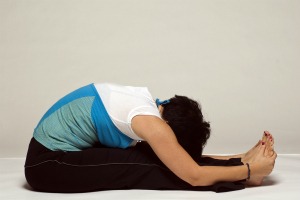Paschimothanasan provides a comprehensive stretch to the entire back of the body from the neck down to the heels. The name for the pose comes from the Sanskrit word ’Paschi’ meaning ’West’ (a metaphor for the back of the body).
Preliminary Stretch
From the Corpse Pose (relaxation lying flat on the back), bring the feet together and bring the arms up parallel to the ears. Stretch first the right side, then the left and finally both sides, making the body as long as possible. Release the stretch and sit up.
Coming into the position
- Keeping the legs straight and the toes back towards the body, inhale and stretch both arms up over the head.
- Retaining the stretch and bending from the hips, exhale and stretch forward, reaching for the toes.
- Keeping the back as straight as possible, try to catch hold of the toes. If you are unable to reach the toes, hold the ankles or the shins.
- Bring the chest as close to the thighs as possible. Keep the knees straight. Hold the feet together; do not permit the feet and legs to rotate outward. Try to have the feet flat with the toes back towards the head.
Holding the position
Beginners may hold the position for 30 seconds. Repeat the pose 3-4 times.
Intermediate/Advanced students may stay in the position for longer periods rather than coming up and down. Gradually increase the time the position is held, the optimum being approximately 5 minutes. Breathe deeply while the position is being held. You may imagine that you are breathing into the hips and, with each exhalation, you are exhaling a bit of the tension from the lower back. As the tension is released, you will feel the body sinking downward. Try to keep the thigh and calf muscles relaxed. Do not bounce; do not try to force the body downwards.
To come out of the position
Inhale and stretch up to the starting position with hands up towards the ceiling. Relax the arms and come into the counter pose.
Benefits of the Forward Bend
- The Hatha Yoga Pradipika, considered to be the classic guide for the advanced practice of Hatha Yoga, says of Paschimothanasan:
”This most excellent of asanas, Paschimothanasan, makes the breath flow through the Sushumna, rouses the gastric fire, makes the loins lean and removes all diseases”.
- Paschminothansan is a specific for corpulence and for the enlargement of the spleen and liver.
- A powerful massage and stimulation of all abdominal viscera, Paschimothanasan stimulates and tones all the digestive organs and increases the digestive fire.
- The Forward Bend is said to invigorate all the internal organs thus reducing body fat.
- A massage is given to the kidneys, liver, pancreas and other organs in the abdominal cavity.
- It regulates the pancreas function which controls carbohydrate metabolism and blood sugar levels. This makes it an invaluable asana for diabetes patients and people with hypoglyemia.
- The intestines are regulated, peristalsis is increased. Thus Paschimothanasan aids constipation and other problems of the digestive tract.
- Paschimothanasan invigorates the entire nervous system.
- Joints are mobilized, the spine becomes elastic and perennial youth is established.
- It provides a full stretch of the posterior of the body.
Common mistakes
INCORRECT: Back rounded, Forcing forehead to knees, Feet apart and rotating to outside, Knees bent
CORRECT: Back flat, Body relaxed with good alignment, Toes pulled back and heels pushing away, Legs straight, Chest on thighs
Counter position – Inclined Plane
- Sitting upright with the legs straight, bring the hands flat on the floor behind the back with the fingers pointing backwards.
- Drop the head back and try to bring the shoulder blades together.
(Keep the mouth closed).
- Lifting the hips up as high as possible, try to bring the feet flat onto the floor. Keep the feet together; do not turn them outward. Keep the knees straight. Beginners may hold the position for 10 seconds. More advanced students will gradually increase the time for up to 1 minute.
- Release the position. Sit down on the ground and shake out the wrists.
Stretch the arms straight out in front and slowly roll down onto the back. Relax in the Corpse Pose.


No Comments